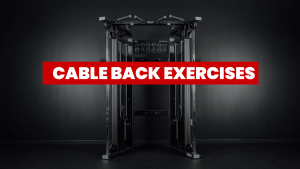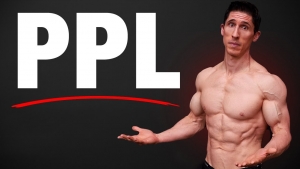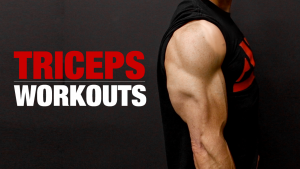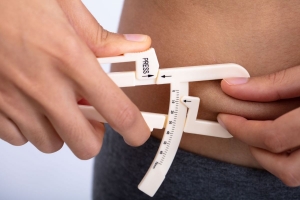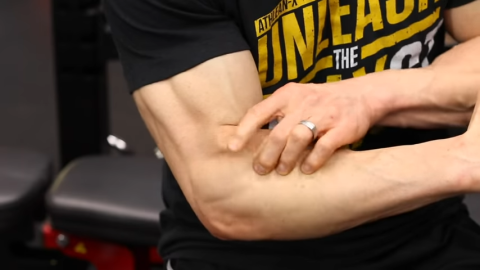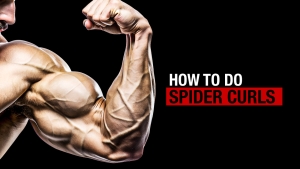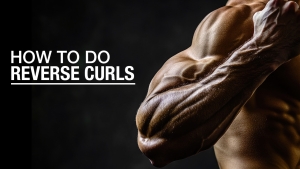
ARE YOU DOING PREACHER CURLS WRONG?
If you’re looking for a powerful exercise to blow up your biceps brachii muscles and take your arm exercises to the next level, Preacher Curls should be on your radar.
Maybe this exercise is already a part of your biceps workout. But chances are, you’re doing them wrong.
Hey, it’s easy to mess up this exercise because most guys start off wrong as soon as they sit down.
You see, the starting position determines whether this exercise will make or break you.
In this post, I’m going to explain everything you need to know about how to do the Preacher Curl.
There’s going to be a huge focus on the perfect Preacher Curl setup, especially mastering that tricky starting position.
Let’s get started!
PREACHER CURLS: MUSCLES WORKED
The Preacher Curl is an isolation bicep exercise that puts all the focus on the elbow flexor muscles, making it a super popular, time-tested exercise in any strength training workout.
But here’s the deal—most people butcher their form on the Preacher Curl bench, turning what should be a muscle-building masterpiece into a bicep and shoulder-wrecking mess.
I want to make sure this doesn’t happen to you and in order to do that, it’s important to understand the muscles that are targeted by the Preacher Curl exercise.
Why does that matter?
Because building muscle mass isn’t just about lifting heavier weights or cranking out more reps. It’s about control, precision, and that all-important mind-to-muscle connection.
When you truly connect with your bicep brachii muscles, you’re not just going through the motions.
You’re actively engaging the target muscle, maximizing tension at every phase of the curl movement, and minimizing the risk of unnecessary strain on your shoulder joint or elbow joint.
By understanding the muscles worked and building that mind-to-muscle connection, you’ll not only see better results in muscle hypertrophy and strength, but you’ll also protect your joints, achieve healthier shoulders, and avoid the common pitfalls that can lead to muscle tears or poor form.
Let’s dive into the specific muscles targeted with Preacher Curls:
BICEPS BRACHII: SHORT HEAD
The short head of the biceps brachii is responsible for adding thickness and mass to the upper arm.
Positioned on the inner side of the bicep, it plays a key role in creating that full, rounded appearance many strive for in their training plan.
The short head is heavily activated during exercises that emphasize a closer grip, such as Narrow Arm Preacher Curls, Dumbbell Curls, and variations using a curl bar or EZ curl bar.
Its involvement makes the Preacher Curl a perfect choice for isolating this portion of the biceps muscles, especially when proper positioning for biceps curls is maintained on the Preacher Curl pad.
BICEPS BRACHII: LONG HEAD
The long head is what gives the biceps their peaked appearance when flexed.
Located on the outer part of the bicep, it adds definition and height to the muscle.
Stretching the long head during movements like the Preacher Curl is particularly effective, as the angle created by the preacher bench keeps tension on the muscle throughout the entire curl movement.
This makes the Preacher Curl one of the best exercises for developing the long head, setting it apart from other types of bicep curls, such as Standing Barbell Curls or Concentration Curls.
For added variety, consider incorporating Cable Curls or Scott Curls to complement your focus on the long head.
BRACHIALIS
The brachialis, which lies beneath the biceps brachii, is another key player in the curl movement.
This muscle is often overlooked but plays a major role in enhancing arm thickness by pushing the biceps upward.
The brachialis is heavily engaged when using an underhand grip with an EZ curl bar or curl bar.
BRACHIORADIALIS
Finally, the brachioradialis, a muscle in the forearm, provides support during the exercise.
While it is not the primary target muscle, its engagement ensures smooth, controlled movement and contributes to overall arm strength.
HOW TO DO THE PREACHER CURL
The Barbell Preacher Curl is one of the most effective options for isolating the bicep muscles, helping you achieve serious muscle growth when performed with proper exercise technique.
While many treat it like a simple variation of the Traditional Barbell Bicep Curl, the starting position is what sets it apart and determines whether you maximize the benefits of preacher curls or waste your time with sloppy form.
When done correctly, the Preacher Curl locks your arms into place on the Preacher Curl pad, removing body momentum from the equation.
This setup isolates your biceps better than most other types of bicep curls, including Standing Bicep Curls or even the Hammer Curl position.
But as I mentioned, it all hinges on the starting position. If you just flop down on the seat with no focus on your body position, you’re asking for trouble.
Let’s break down exactly how to do the Preacher Curl, starting with that all too important setup.
BARBELL PREACHER CURL


HOW TO DO THE BARBELL PREACHER CURL:
- First, set up your preacher bench so the preacher curl pad is at a comfortable shoulder height, allowing for a slight forward lean.
- Grab a bar for curls, like an EZ curl bar, which is often a popular option due to its ergonomic grip.
- Place your hands shoulder-width apart on the bar, with a slight outward angle for comfort and control.
- Use an underhand grip to ensure full activation of the bicep muscles during the curl movement.
- Shift your upper body weight forward to create solid contact between your elbows and the preacher curl pad. Driving your elbows firmly into the pad sets the foundation for a smooth and controlled curl.
- Keep a slight bend in your elbows at the bottom to avoid locking out and putting unnecessary strain on the joint.
- Engage your arm muscles and keep your shoulder blades pulled down for optimal tension on the biceps brachii.
- Slowly lower the weight, pause at the bottom, and engage the biceps muscle to bring the bar back up. Rinse and repeat.
WHAT MAKES IT EFFECTIVE: The starting position of the Preacher Curl eliminates reliance on secondary muscles and minimizes the risk of muscle tears, giving you a safer, more effective path to muscle hypertrophy. In particular, the forward lean ensures that your arms are fully supported and eliminates unwanted motion from your shoulders or body stability issues.
DUMBBELL PREACHER CURL


HOW TO DO THE DUMBBELL PREACHER CURL:
- First, set up your preacher bench with a pad height that keeps your shoulder health in check. The bench should allow you to comfortably rest your arm with the dumbbell while maintaining proper posture of preacher curls.
- Select a lighter weight if you are new to the Narrow Arm Dumbbell Preacher Curl, as proper form is more important than maxing out the load.
- As you approach the bench, focus on creating the right alignment. Sit with your feet shoulder-width apart for balance and plant them firmly on the ground.
- Shift your body strength slightly forward so your upper arm makes solid contact with the preacher curl pad. This forward lean drives your elbow into the pad, locking it in place.
- Start with your arm fully extended but maintain a slight bend at the elbow to avoid unnecessary stress on the joint.
- Engage the biceps by curling the dumbbell upward in a controlled motion, keeping the tension throughout.
- At the top of the curl, pause briefly to maximize contraction in the lateral head and medial head of the biceps before lowering the weight slowly.
WHAT MAKES IT EFFECTIVE: This meticulous setup transforms the Dumbbell Preacher Curl from an ordinary movement into a precision tool for training biceps. This setup eliminates unwanted movement and ensures your biceps, not extra muscles, are doing all the work. Mastering this starting position ensures every rep counts, making the bicep curl enjoyable and a key component in your perfect training plan.
PREACHER CURLS: COMMON MISTAKES
If you want to turn the Preacher Curl into the ultimate bicep builder, you need to avoid the mistakes that turn this iconic bodybuilding muscle exercise into a waste of time or worse, an injury risk.
Correcting these common mistakes will help you get the most out of the Preacher Curl and build the arms you want.
Treat it as more than just another exercise in your upper body sessions.
Use it strategically as part of a perfect training plan that prioritizes form, consistency, and a comprehensive approach to training biceps.
Let’s break down the most common errors and how to correct them, so every rep contributes to your muscle growth.
USING TOO MUCH WEIGHT
The Preacher Curl is about control, not ego lifting. Grabbing a bar that is too heavy sacrifices form and shifts the load to extra muscles like the shoulders.
This eliminates the benefits of isolating the biceps and puts unnecessary strain on your shoulder health.
Stick to a lighter weight that allows for strict, controlled reps. If you cannot maintain proper posture of preacher curls, reduce the load and rebuild your strength gradually.
POOR ELBOW PLACEMENT
Failing to lock your elbows firmly into the preacher curl pad is a recipe for disaster.
Floating elbows reduce tension on the biceps and invite instability into the movement.
Shift your weight slightly forward when setting up, ensuring your elbows are fully supported and driving into the pad.
This creates a stable base for isolating the lateral head and medial head of the biceps.
RELYING ON MOMENTUM
Using momentum during the curl movement by swinging your torso or lifting your elbows off the pad is one of the biggest reasons for poor results.
This turns the Preacher Curl into a sloppy variation of the Standard Bicep Curls and limits activation of the biceps brachii.
Keep your body still, focus on strict form, and let the biceps do all the work.
INCOMPLETE RANGE OF MOTION
Cutting the range of motion short, either at the top or bottom of the curl, robs you of potential muscle growth.
Lower the bar until your arm is almost fully extended, maintaining a slight bend to protect the joint.
Curl all the way to the top, fully contracting the biceps. Avoiding this mistake ensures you get the most out of every rep.
NOT MIXING IT UP
Relying solely on one type of Preacher Curl without incorporating preacher curl variations can lead to stagnation.
Incorporate Narrow and Wide Arm Dumbbell Preacher Curls, Cable Bicep Curls, or Spider Curls into your exercise program to challenge the biceps from different angles.
These alternatives to preacher curls can keep your training fresh and prevent plateaus.
CURLS IN COMPARISON
Curls are one of the most popular options for targeting the biceps, but not all curls are created equal.
The Preacher Curl stands out for its strict form and isolation, but how does it stack up against other variations of bicep curls?
Let’s take a closer look at how Preacher Curls compare to Bicep Curls, Barbell Curls, and Hammer Curls, while highlighting key differences between preacher curls.
PREACHER CURL VS BICEP CURL
The Preacher Curl is designed to eliminate momentum and lock your arms into place using the Preacher Curl pad.
This makes it a top choice for isolating the biceps and achieving precise activation of the muscle.
In comparison, Bicep Curls—such as the Standard Curl or Bar Biceps Curl—offer more flexibility in terms of setup and movement.
You can perform unilateral curls with dumbbells, adjust your grip, or even incorporate a standing exercise to engage stabilizing muscles.
While Bicep Curls provide versatility and are often included in programs as a foundation for exercise for building strength, the Preacher Curl is better for strict, focused work on the biceps, especially for lifters looking to target weaknesses or achieve controlled tension.
PREACHER CURLS VS BARBELL CURLS
The Barbell Curl is an infamous exercise known for helping lifters increase in weight to build bigger, stronger arms.
It allows you to lift heavier than most variations of bicep curls, making it ideal for developing overall strength.
However, this comes at a cost. The Barbell Curl often involves slight body sway or momentum, which reduces isolation.
In contrast, the Preacher Curl locks the elbows into place on the pad, eliminating the chance of using momentum.
This strict form makes it a more effective option for targeting the biceps directly.
While the Barbell Curl is great for mass-building as part of a standing exercise program, the Preacher Curl offers superior muscle isolation, making it a valuable addition to any routine focused on arm definition.
HAMMER CURLS VS PREACHER CURLS
Hammer Curls shift the focus to the brachialis, a key muscle that adds thickness to the upper arm.
This makes them a great alternative to preacher curls when you want to work a slightly different part of the arm.
Hammer Curls can also be performed as unilateral curls, offering more variety and range of motion.
The Preacher Curl, on the other hand, specifically targets the biceps brachii, particularly the long head.
It locks your arms into position, making it ideal for isolating and maximizing tension on the biceps.
While both are excellent choices for building strong arms, Hammer Curls are better suited for targeting the brachialis and forearms, whereas Preacher Curls are the go-to for bicep-focused training.
DIFFERENCES BETWEEN PREACHER CURLS
The Preacher Curl is not a one-size-fits-all exercise.
The Bar Preacher Curl emphasizes strength and size by allowing you to use a barbell, while the standard Dumbbell Biceps Curl performed on a preacher pad allows for more control and symmetry in arm development.
Adding cables with a curl attachment provides constant tension throughout the movement, which is another great alternative to preacher curls performed with free weights.
These subtle variations in setup and pieces of equipment make the Preacher Curl a versatile tool for targeting the biceps while accommodating different training goals and experience levels.
By understanding these differences, you can tailor the Preacher Curl to fit perfectly into your training program and maximize your results.
The Preacher Curl is a powerhouse for building bigger, stronger biceps, but only if you perform it with precision and purpose.
By locking in your form, focusing on controlled movements, and avoiding common mistakes, you can maximize the effectiveness of this classic exercise.
Add it to your training routine and watch your biceps grow.
Check out our complete line of ATHLEAN-RX Supplements and find the best training program for you based on your fitness level and goals.

- The Preacher Curl isolates the biceps for maximum muscle activation, eliminates momentum for stricter form, and builds strength and size while reducing strain on the joints.
- Here’s how to perform the Preacher Curl exercise:
- Adjust the preacher bench so the pad is at the right shoulder height, letting you lean slightly forward for better positioning.
- Grab an EZ curl bar, a popular option thanks to its comfortable grip, and set your hands shoulder-width apart with a slight outward angle for stability.
- Use an underhand grip to fully engage your biceps brachii and lock in proper muscle activation during the movement.
- Shift your weight forward to drive your elbows firmly into the preacher curl pad, creating a solid base that eliminates momentum and isolates the biceps.
- Keep a slight bend at the bottom to protect your joints, avoiding the risk of locking out your elbows.
- Pull your shoulder blades down and engage your biceps as you curl the weight up.
- Lower the bar slowly under control, pause briefly at the bottom, then power through another rep with full tension. Keep it strict, and your biceps will thank you.
PREACHER CURLS FAQ
The Preacher Curl is one of the most respectable exercises for building the size and definition of your biceps brachii.
By isolating the biceps, this exercise type eliminates reliance on momentum, making it far superior to compound exercises or standard barbell curls when the goal is focused muscle growth.
What makes the Preacher Curl so effective is the setup. Using a bench preacher curl attachment, your arms are locked into place on the pad.
This positioning eliminates unnecessary movement and ensures the biceps do all the work, rather than relying on secondary muscles.
Compared to a Traditional Bicep Curl or Curls vs Barbell Curls, the Preacher Curl forces a stricter range of motion, which leads to greater muscle activation and more effective results.
It is also an excellent tool for those looking to protect their joints. The controlled movement and stable setup promote healthier joints by minimizing strain on the shoulders and elbows. This makes it a great addition to upper body sessions for athletes of any training age.
This move deserves a spot in comprehensive exercise libraries. Whether you are a beginner looking to master the correct exercises or an advanced lifter aiming to increase your biceps' size and strength, the Preacher Curl is one piece of equipment you do not want to overlook.
To perform Preacher Curls correctly, start by selecting the right pieces of equipment, such as a Preacher Curl pad and an appropriate weight.
Sit on the bench with your bar with shoulder width grip firmly set on the bar. Adjust your position so your elbows rest securely on the pad.
Shift your upper body slightly forward to drive your elbows into the pad for full support. This eliminates momentum and ensures your biceps are fully engaged.
With a controlled movement, curl the weight upward by contracting your biceps.
Pause briefly at the top to maximize the squeeze, then slowly lower the bar until your arms are nearly straight.
Avoid locking out your elbows to keep tension on the muscle.
The Preacher Curl and Bicep Curl both target the biceps, but their execution and focus differ.
The Preacher Curl isolates the biceps by locking your elbows into place on a pad, eliminating momentum and forcing the biceps to handle the full load.
This makes it highly effective for precision work and strict muscle engagement.
On the other hand, the Bicep Curl includes a variety of forms, such as Standard Curls, Standing Curls, and Unilateral Curls.
These allow for more movement freedom and engage stabilizing muscles.
While the Preacher Curl focuses entirely on the biceps, the Bicep Curl can be adapted to include plenty of exercises for overall arm development.
Yes, Preacher Curls are one of the most effective exercises for building bicep mass.
By isolating the biceps and eliminating assistance from other muscles, the Preacher Curl puts maximum tension on the target muscle. This leads to greater activation, which is crucial for hypertrophy.
For lifters aiming to build mass, using a bar with shoulder width grip and gradually increasing weight over time is key.
Incorporating Preacher Curls into your routine alongside other mass-building movements ensures a well-rounded approach to arm growth.
REFERENCES

Jeff Cavaliere M.S.P.T, CSCS
Jeff Cavaliere is a Physical Therapist, Strength Coach and creator of the ATHLEAN-X Training Programs and ATHLEAN-Rx Supplements. He has a Masters in Physical Therapy (MSPT) and has worked as Head Physical Therapist for the New York Mets, as well as training many elite professional athletes in Major League Baseball, NFL, MMA and professional wrestling. His programs produce “next level” achievements in muscle size, strength and performance for professional athletes and anyone looking to build a muscular athletic physique.






